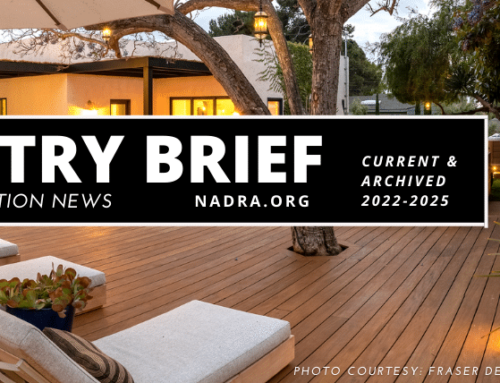March, 2019
The Deck Future in the Making, By Glenn Mathewson
Professionals are now planning and strategizing their proponent and opponent testimonies for delivery at the Committee Action Hearing in Albuquerque the first week of May. NADRA will be proudly supporting nine proposals that came together through the effort and contribution of many professionals and organizations from a variety of backgrounds, and are thus the kind of ideas that NADRA was proud to cosponsor. For a building code to honestly and respectfully represent a civilization, the whole civilization should be invited to their creation.
NADRA invites all those with interest in deck codes to share and contribute together with us and those we work with. We strongly believe that is path to the most appropriate, minimum standard.
Here are your 2021 IRC deck-related code proposals and a simple summary:
RB50-19: Increase minimum design load for decks from 40 psf to 60 psf. This is the proposal the decking industry must pay the greatest attention to. It raises the minimum required design load from 40 psf, as it has been for all of time, to 60 psf. Whether you agree with this or not, the proposal did not include any new prescriptive design tables to accommodate the increase. Rather, they added a footnote that the 70 PSF SNOW LOAD table must be used. Ironically…this table does not yet exist. It only exists in the DCC/NADRA proposal that offers expanded design tables for regions with greater snow loads, such as 50, 60 & 70 psf.
Our proposal was intended to allow the IRC to be used for design in the few pockets of the country with large snow loads. RB50-19 takes the largest of those snow loads AND APPLIES IT TO THE ENTIRE COUNTRY. Florida would be building decks as they are built in the Rocky Mountains. Denver would be building decks equivalent to the live load combined with the snow load. When is the last time you had people shoulder to shoulder on a deck with multiple feet of snow?
The second proposal that appears to have the greatest impact on the decking industry is RB106-19. This proposals offers new prescriptive requirements for deck stair construction, including the minimum remaining cut of stringers, number of stringers, securing and bearing area, and maximum span of stringers. The remaining proposals certainly need our review and I believe can certainly use our contribution, whether in support or in opposition—with included constructive criticism.
These remaining proposals have some effect on the decking industry, and should be reviewed by the industry. I will be providing my recommendations to NADRA, but now is the time for YOU to speak up. Do you support these proposals? …Do you not? Are you going to do anything with that opinion?…Or will you not?
RB20-19: New definition for a “porch” including specifics regarding its separation from the dwelling and conditioning of the space.
RB59-19: Requirement to extend the fire-resistance rated wall that separates townhomes to a height of 8 feet above a rooftop deck.
RB97-19: New limitations and requirements for emergency escape and rescue opening covers.
- Could prohibit extension and termination of window wells up to deck levels
- Requires cover to remain open upon opening
- Limits weight of cover to 25 lb.
RB99-19: Requires the minimum 36-inch high path under a deck from an escape opening to now also be a minimum of 36 inches wide.
RB105-19 & 106-19: Clarifies that only stairs and ramps connected to a building, porch, or deck must comply with code.
RB112-19: Reduces the maximum stair rise from 7 ¾ inches to 7 inches and increases the minimum tread depth from 10 inches to 11 inches.
RB113-19: Allows an exterior stair landing that is also critical to water drainage to slope up to 1:48 from the previous ¼:48 limit.
RB114-19: Allows a continuous handrail to be interrupted or offset by up to 6 inches and still be considered continuous.
RB116-19: Removes all provisions regarding stairway geometry and references an NFPA document for the requirements.
RB118-19: Removes reference to “walking surfaces” for required guards and replaces with the term “floors”
RB119-19: Requires ALL guards to be a minimum of 36 inches high. Currently only “required” guards must be this high.
RB136-19: Removes the provision that requires the building official to determine if local experience demonstrates a need for decay resistances of deck framing and replaces it with a direct requirement for decay resistance where the deck is not protected from the weather.
RB192-19: Expands the allowable band joist material for ledger connections from specific species to any code-compliant engineered wood rim board.
If you are in the decking industry, we need your help. The ideas are being discussed and the rules are being made. You shouldn’t stand on the sidelines any longer. We need you in the game. There are two ways you can help in a big way:
1. Offer your monetary support: To contribute to the fundraising initiative, follow this link here to see what our goal and how the funds are being used to keep this effort moving forward.
2. Offer your time: To volunteer time, please email Info@NADRA.org and we will work with you and the code committee to see how we can best utilize your skills – most likely, helping to review the proposals in March.
The proposals for the creation of the 2021 IRC have been released for review and can be viewed HERE.



